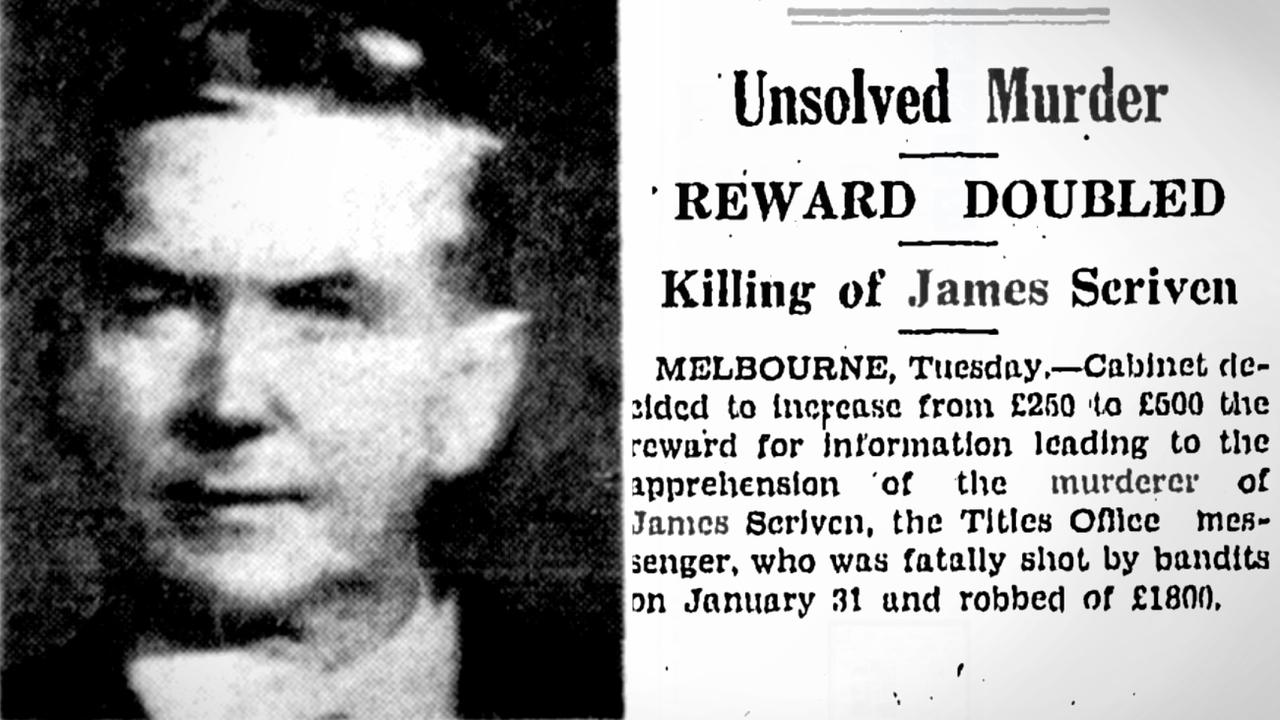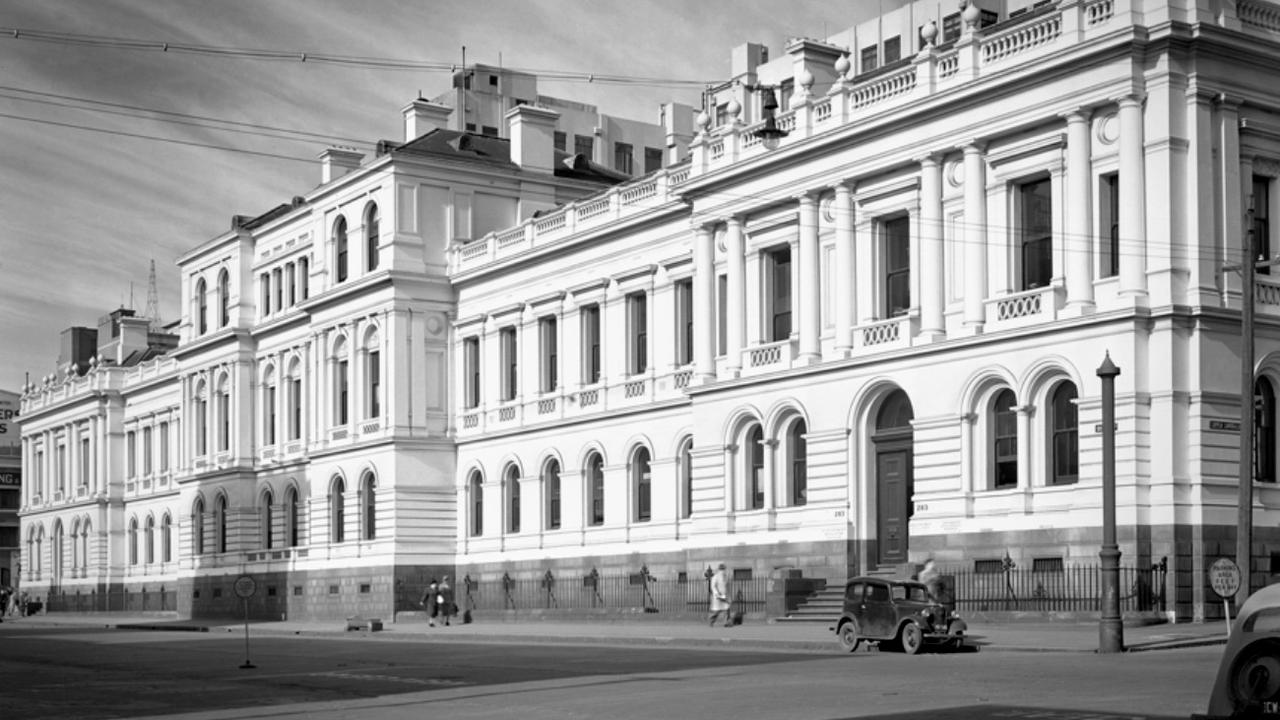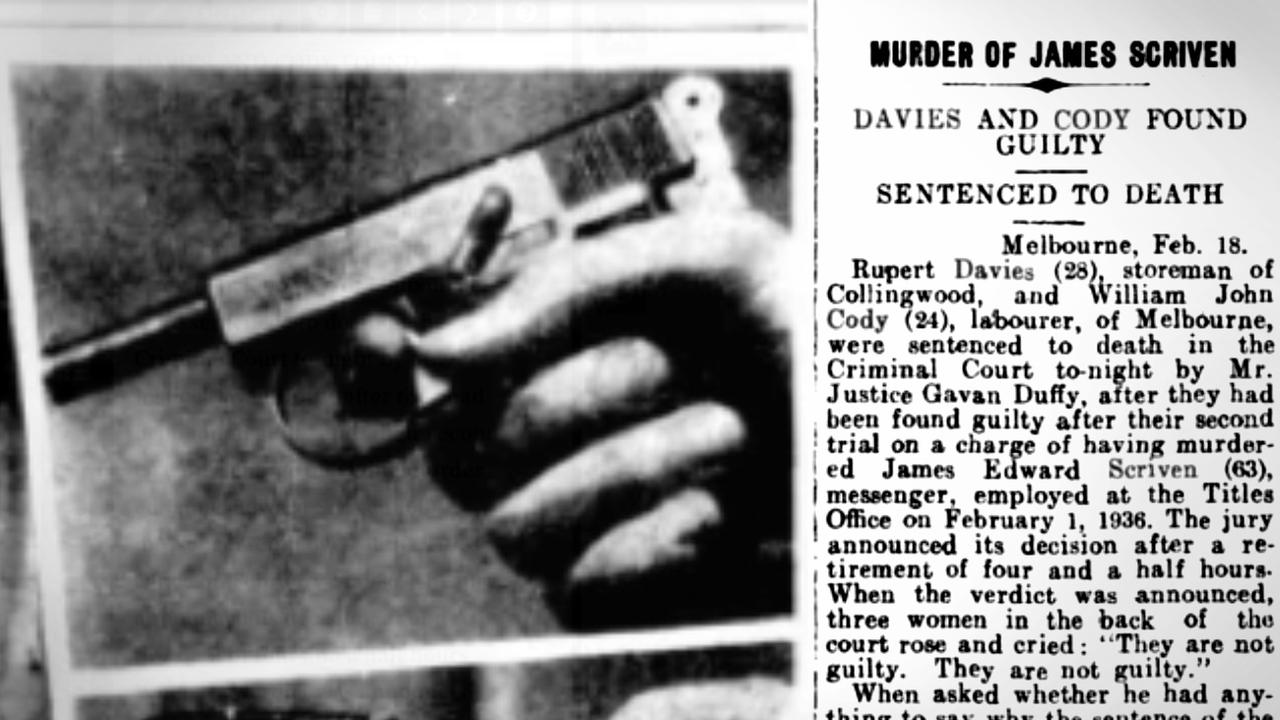How routine bank drop ended in one of Victoria’s most shocking murders
It was a brazen heist in Melbourne’s CBD that ended in murder, but decades on there is still uncertainty about who pulled the trigger.

From his office window overlooking Little Lonsdale Street, Mr W Carner watched £1800 – about $160,000 in today’s money – walk out the door.
Carner, the Deputy Comptroller of Stamps in the Titles Office, had instructed a young clerk to take the day’s takings straight to the bank.
It was late on a Friday afternoon in January 1936, and the clerk, 18-year-old Herbert Gillbank, was clutching the treasure as he exited the building towards a waiting taxi.
The money had been carefully counted and was bound by rubber bands, locked in a metal box, which itself was sealed in a locked bag.


Following closely behind Gillbank as he strode out onto the busy footpath, was the security.
Experienced guard and former prison warder James Scriven, 64, had a revolver in his pocket and wasn’t afraid to use it on anyone who dared to make a dash for the cash.
It was a routine procedure and they weren’t expecting any trouble.
Still, something made the Deputy Comptroller peer out the window that fateful afternoon, and he became witness to one of the most shocking robberies and murders in the state’s history.
Young Gillbank entered the taxi and put the bag containing the money between his feet.
As Scriven stooped to enter the car, two men emerged from the afternoon bustle and flung him back against the taxi.
As one man fought with Scriven, who was struggling to reach his gun, the other man dived into the cab and wrestled the bag off Gillbank.

Once the prize had been claimed, the man who took the money re-emerged from the taxi.
Scriven was about to pull his revolver, but it was too late.
The robber fired a shot through the guard’s head at close range.
There was panic on Little Lonsdale St.
Even the shooter must have been flustered. His pistol was dropped to the gutter and the two bandits sprinted to a waiting blue car and sped off.
The taxi driver, Reginald Pullen, scooped up the pistol from the ground, took chase on foot after the bandits’ car and attempted to fire a shot at the tyres, but the safety was on.
A passing council worker, Mr F Denten, also took chase in a car, but the bandits got away.
Scriven was taken to hospital with a bullet lodged in his brain. He died the following day.
Two days later George Theodore, a Kew resident, made a trip to Brighton Beach where he waded for mussels.
Knee deep in water, he spotted something strange.
A padlock was sticking out of the water. When he tugged on it, he found a bag that had been slashed open with a knife.
Inside the bag was a metal box, which itself had been forced open.
And inside the box was a clump of rubber bands, which had once held the money.
Police were now hunting a murderous gang of robbers in a case that gripped Victoria.
CASH REWARD
Despite numerous witnesses on Little Lonsdale St, and a huge cash reward offered by the government, police had little to go on.
At one stage they believed they had a credible suspect, and were so keen to track him down that his image was shown at cinemas around Melbourne.
About a month after the killing, police became convinced the true killer was actually hiding in Sydney.
Then it was revealed an anonymous letter containing valuable information had been sent to police, who demanded its sender come forward.

As the months passed without an arrest, the reward for information was doubled.
Then a breakthrough came almost ten months after the crime when police announced three men were being held over the robbery and murder, after a dramatic foot chase through the Carlton Gardens in which shots were fired at police.
The suspects were William Cody, 24, a labourer who lived in King St, Geoffrey Davies, 32, a cook from Collingwood and his brother Rupert Davies, 28, a storeman also from Collingwood.
The public was shocked to find out the career crooks had also been embroiled in the shooting of a policeman in May the same year.
Superintendent John Brophy had driven to Royal Park to meet with an informant when he was met with a volley of bullets that almost killed him.
He was left with injuries to his arm, cheek and shoulder.
Brophy swore in court that Geoffrey Davies had pulled the trigger.
But nothing ever came of it.
The murky politics of the police high command, who initially treated the Brophy shooting as an accident, had led to controversy and a royal commission.
Now William Cody, suspected of being involved in the police shooting, was being charged with the murder of James Scriven alongside the younger Davies brother Rupert.
Something didn’t sit well with the case.
A new revelation came from a witness, a fellow crook, who said Cody had confessed to him about the Scriven murder.

But the witness later changed his story, saying he was scared the police were going to frame him for the murder if he didn’t implicate Cody.
Then he sensationally changed his story back.
Whatever was playing out behind the scenes, Cody and Rupert Davies were trialled for the murder of Scriven.
When a jury convicted them, they were sentenced to death.
Given the opportunity to speak in court, Cody insisted: “I am innocent of this crime. I have been framed for this trial from the start to the finish and, what is more, the police know I am not guilty.”
It was suggested Cody and Davies were fit up for the crime due to their long-running battles with police.
Ultimately the death penalty didn’t stick.
A High Court appeal saw a retrial ordered, and after a string of jury disagreements and a total of five trials, Rupert Davies and William Cody were found not guilty.
Ultimately the robbery and murder on Little Lonsdale St went unsolved.
But the crime had a lasting legacy.
Shortly after the shocking murder, armoured vehicles were used to transport large amounts of money for the first time.
More Coverage
Originally published as How routine bank drop ended in one of Victoria’s most shocking murders




